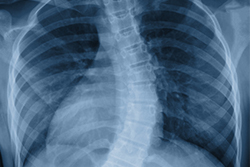Targeted Exercises may be Helpful in Treatment of Scoliosis

“Stand up straight!”
What child hasn’t heard that from a parent at one time or another? Indeed, having good posture helps promote overall health, and is made possible by a spine that is strong and aligned. There are times, however, when a certain deformity of the spine makes proper posture more difficult — a condition known as scoliosis.
According to Dr. William J. Higgins, chief medical officer and vice president of medical affairs at NewYork-Presbyterian Hudson Valley Hospital, “Scoliosis is a curvature of the spine and trunk that appears in otherwise healthy children. The spine appears to be growing sideways, developing into an ‘S’ shape or a ‘C’ shape. The condition can progress during the ‘growth spurt’ years but usually not after adulthood.”
Scoliosis is the leading spinal problem affecting school-aged children. The primary age of onset and diagnosis by a physician is between 10–15 years old, and girls are more likely to be affected than boys are. Dr. Renee Lemieux, PT, DPT, a Certified Physical Therapist with NewYork-Presbyterian Hudson Valley, explains: “Most cases of scoliosis are mild, but some children develop spinal deformities that become more pronounced as they grow. Severe scoliosis (a spinal curvature of greater than 40 degrees) can be disabling. An especially severe spinal curve can cause respiratory problems — reducing the amount of space within the chest, and making it difficult for the lungs to function properly.”
There are many types of scoliosis that involve the thoracic spine, lumbar spine or both. The most common form is idiopathic scoliosis, affecting over 4 million people in the United States. Notes Dr. Higgins, “Its exact cause is still unknown, however, there is evidence that links the condition to genetics.” Other types include congenital scoliosis (caused by a bone abnormality at birth); neuromuscular (a result of abnormal muscles or nerves, frequently seen in people with spina bifida or cerebral palsy); and degenerative (a result of traumatic injury or illness).
Symptoms commonly appear during adolescent years, when the curvature of the spine may cause the person’s posture to look asymmetrical. “For example,” says Dr. Lemieux, “the shoulders or waist creases may be at different heights from side to side, or when bending forward the ribs on one side of the trunk may protrude more.” Some patients may report back pain, and a misalignment of the shoulders, hips, and waistline may be visible to varying degrees.
Treatment options
The goal of treatment for scoliosis is to prevent the spinal curve from getting worse and to correct or stabilize a severe spinal curve. “The variety of treatment options for scoliosis includes physical therapy, bracing, and surgery. The physician will determine the best course of treatment based on the type and severity of the scoliosis and the patient’s age. The physician may also prescribe physical therapy,” says Dr. Higgins.
Physical therapy may be recommended during all phases of scoliosis, including bracing or post-surgery. Physical therapists evaluate and assess the body’s posture and movement patterns, noting any limitations caused by changes in the spine, and address other symptoms, such as pain and muscle imbalances.
According to Dr. Lemieux, “Treatments have evolved over the past decades from a ‘Wait and See’ approach for small-angle scoliosis (to see if the condition will stabilize), to bracing for scoliosis of moderate angles up to 25 degrees. If the curves are severe, between 45 to 50 degrees, surgery might be recommended.”
One of the newer treatment modalities is based on the Schroth method, which employs three-dimensional exercises to help young teenagers, and even adults, live better with mild to moderate scoliosis.
“These exercises aim at strengthening the back and core muscles, increasing the breathing capacity and hopefully preventing further curve progression,” says Dr. Lemieux. “We start with a physical therapy musculoskeletal evaluation and postural assessment. Based on those results, we will work with the patient on targeted spinal exercises geared toward isometric strengthening, corrective breathing techniques, and body mechanics, in addition to customizing a home exercise program.”
To learn more about scoliosis, visit our health library. To find a scoliosis specialist, call 877-697-9355.


